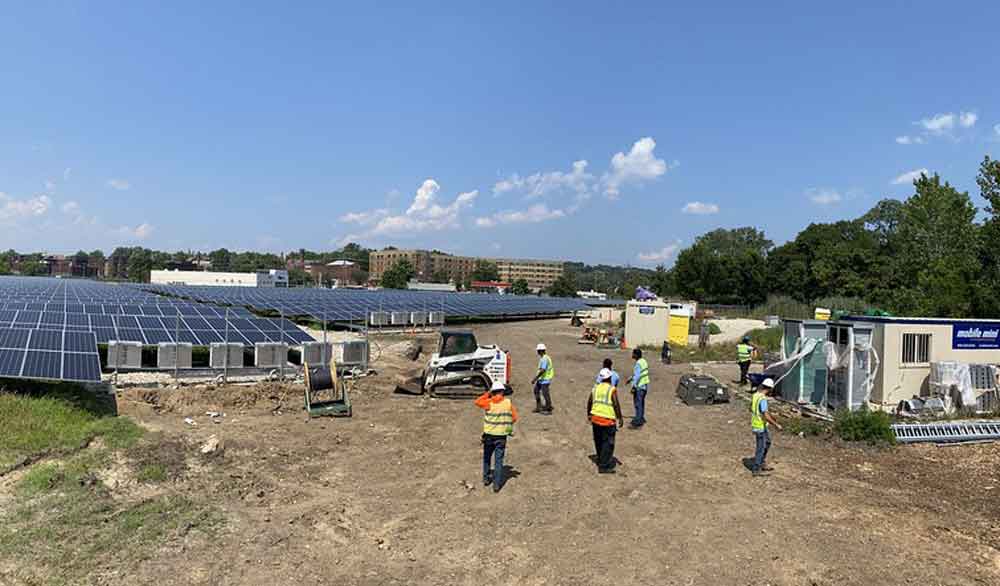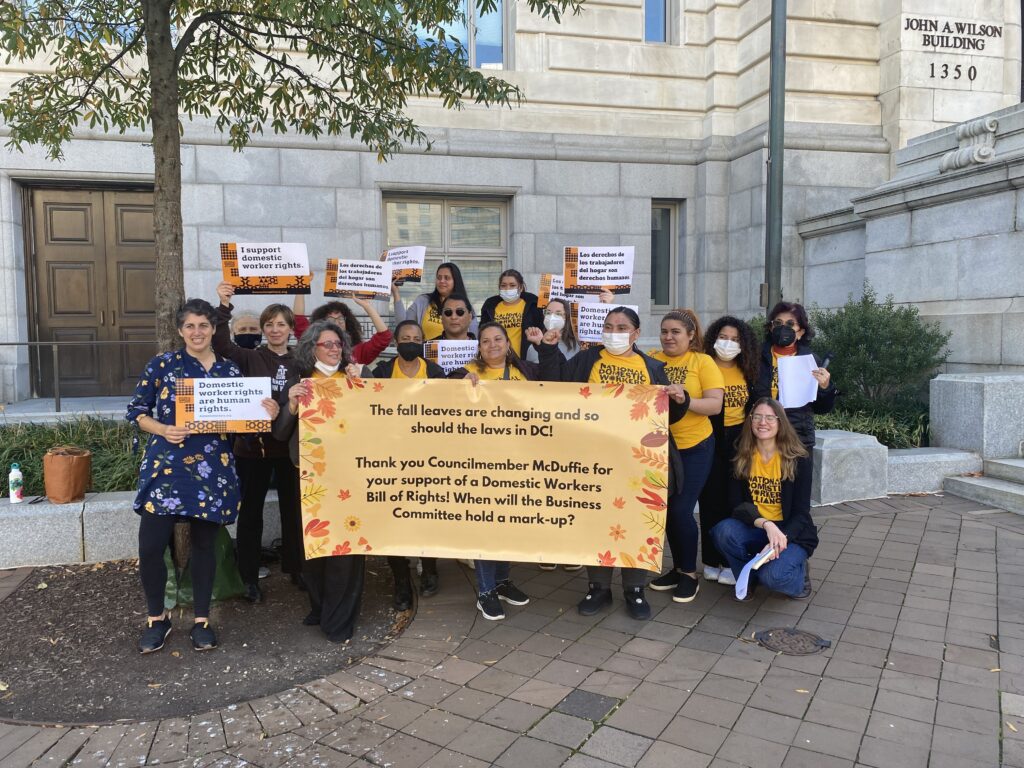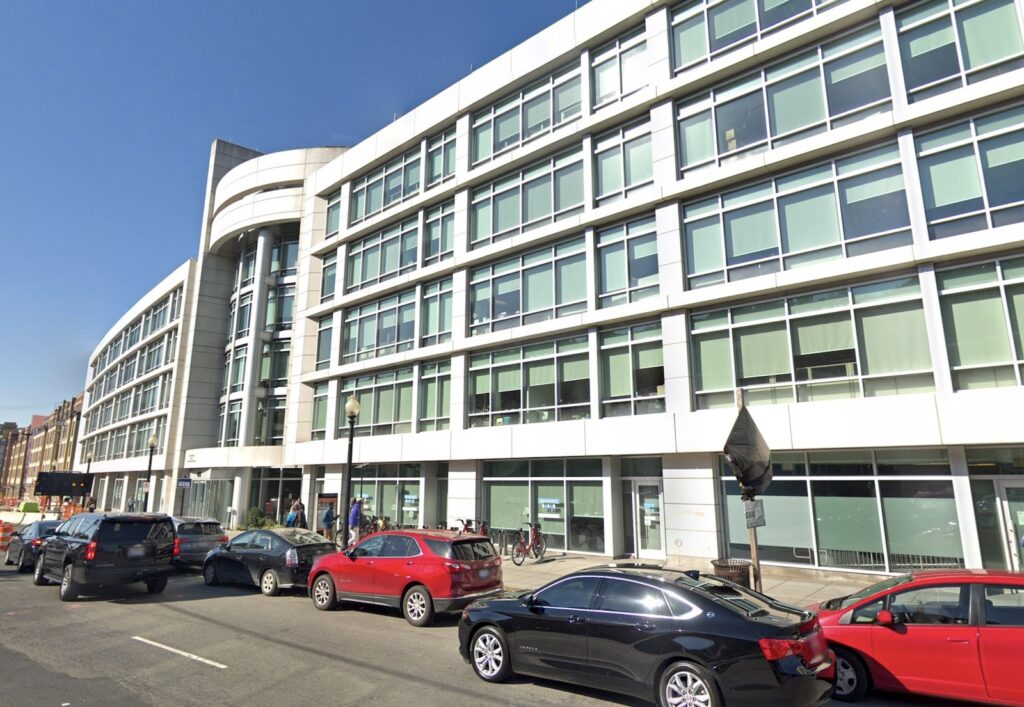Just three years ago, Andre Green had no experience with solar panels besides the tips he picked up from his father, who’s an electrician. Now, he hopes to start his own solar panel installation business.
“I know I can work for myself if I choose to,” said Green, who is currently employed as a teacher. “I’m just now learning like this thing could go a long way.”
In 2018, Green spent 12 weeks installing solar panels on houses in Northeast and Southeast D.C. with the help of Solar Works D.C., a low-income solar installation and job training program led by the Department of Energy & Environment (DOEE), the Department of Employment Services (DOES), and the mayor’s office. It prepares District residents to enter careers in solar and related industries and is implemented by the nonprofit GRID Alternatives, through a grant from DOEE’s Solar for All program. Participants are paid hourly in addition to a stipend provided during the program.
[Disclosure: DDOE is a frequent advertiser with Street Sense Media.]
When Green ran across the program, he was homeless. He signed up for the program, and started earning the stipend for going to class every day. By the end of the three-month training, Green said he had completed four or five installations. He learned about every aspect, from the electrical requirements to getting up on the roof and installing the panels.
“The class taught me a lot as far as how to install solar panels and what would be available to me as far as opportunities in the future,” Green said. “I will be okay if anything happens.”
The only criteria for the program are to be 18 years or older, be willing to get up on a roof, and have the strong desire to give back to the community through the program, according to Elijah Perry, Grid Alternative’s mid-Atlantic development director.

Approximately three in 20 trainees from each cohort are homeless, though you are not required to provide that information when applying as the program is not targeted at people experiencing homelessness, Perry said. Grid Alternatives provides each participant with education on solar installation basics, CPR and OSHA certifications, and access to wraparound services. Everyone who comes through the program meets with a case manager 1-1 who can help connect them, if needed, with food stamps, shelters, temporary housing, and other resources. It’s during these private conversations that workers tend to disclose their lack of stable housing.
“How many of these trainees wouldn’t have asked for help had it not been for the program? It’s a resource within itself,” Perry said. “We want them to have these collective resources … we try to meet people where they are.”
Linda Stroman, one of the case managers and trainers with the program, aids participants with soft skills training, financial management, career development, and other wrap-around services. Families are also included in case management, which Stroman feels is key to improving situations long-term. The provision of those services is one thing that she feels makes Solar Works stand out from other job-training programs.
“It’s helping them kinda create those basic foundations,” Stroman said. “It’s not just about learning about solar, it’s so much more rounded, and that’s why they push the wraparound services, they’re really trying to get people to feel whole again all the way around.”

The 12-week pipeline program aims to produce a qualified workforce for entry-level green jobs in solar and related industries. It also provides free solar installation to low-income residents in the District. The program has trained over 200 people so far, Under the mayor’s Solar for All Program implementation plan, DOEE aims to provide 100,000 low- and moderate-income homeowners access to solar power from rooftop solar panels by 2032, which is estimated to cut participants’ energy bills by 50%. If it sticks to the plan, the District is projected to reduce its “carbon footprint” to zero by 2050.
Households that take advantage of the free installations could save up to $500 per year on their electricity bills, according to DOEE’s website. District residents are eligible for community solar if their household income is below 80% of the area median income: $100,800 for a family of four and $70,550 for a single person.
By the end of the last fiscal year, Sept. 30, 10,000 households in D.C. were anticipated to have been receiving the benefits of solar, either from direct installations, credits, or improved living conditions, according to Cecile Brown, a public affairs specialist for DOEE. The program anticipates installing panels to serve another 2,983 houses by the end of 2020. The number of installations in 2020 has been adjusted due to COVID-19.
The program is within budget, and demand has progressed somewhat ahead of capacity. They have plenty of room to grow, Brown said. The solar development rate continues to rise within the District. The number of permits issued doubled last year from the year before.
The first Solar For All Community Renewable Energy Facility (CREF) in Ward 8, Oxon Run, was installed over the summer. It hosts 7,280 panels, partially installed by Solar Works members, and will provide 750 residents with up to $500 in electricity savings per year.
Solar Works D.C. enrolls new trainees every spring, summer, and fall. Before the coronavirus pandemic, the training program included two days of hands-on solar installation experience per week, filling the other days with a mix of classes and workshops.
Stroman, the case manager and trainer, stays connected with graduates of the program. She said that while a decent number go into solar installation or solar marketing, the skills they acquired are useful no matter where they go next.

“By the end of the program, the way they’re so proud of themselves and we’re proud of what they’re doing, I see an enhanced self-esteem overall in what they can do, adding new skills to their resume, being able to talk about who they are and what they can bring to the table,” Stroman said.
Graduates also have opportunities at Solar Works itself, which hires graduates as panel installers when they can, according to Stroman. Two current instructors previously went through the training program.
The program is still operating and recruiting applicants for upcoming cohorts, but no installation training is taking place in the field due to the health crisis. DOEE and DOES are making sure each trainee has a laptop and internet access, while Grid Alternatives has been implementing a 3D solar installation simulation platform for students to learn and practice installation techniques. The nonprofit’s COVID-19 task force is still developing its guidelines to safely allow trainees back in the field. For now, the full curriculum is implemented virtually, though Perry stressed recruitment is still very much ongoing.
For those interested, Stroman stressed there were no specific qualifications. “It’s about the desire to really do something different, she said. “We’re looking for folks who aren’t just looking for something to get paid for for a couple of months, but see the need for solar installation and how it’s helping the environment.”
Perry of Grid Alternatives said COVID allowed the nonprofit to think more outside of the box about how to engage people who aren’t able to make it into a physical classroom and to build out a more hybrid program.
“A lot of homelessness is tied to economics and opportunity,” Perry said. “We try to create a pathway forward for people to build the life that they want and that they see themselves in.”
Mark Rose contributed reporting.
Residents who would like to see if they qualify for no-cost solar installation on their home should visit https://www.dcseu.com/solar-for-all#get-started.
Residents who would like to enroll in a future Solar Works D.C. training cohort should contact the D.C. Infrastructure Academy: [email protected] or 202-899-6040.








